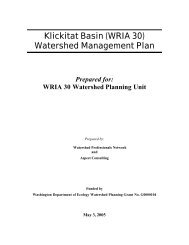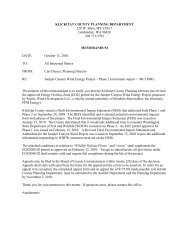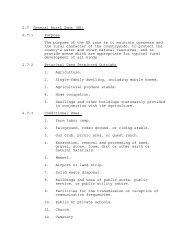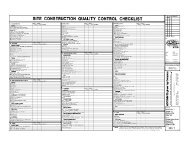WRIA 31 Instream Habitat Assessment
WRIA 31 Instream Habitat Assessment - Klickitat County Home
WRIA 31 Instream Habitat Assessment - Klickitat County Home
Create successful ePaper yourself
Turn your PDF publications into a flip-book with our unique Google optimized e-Paper software.
3.2 SAMPLING PROCESS DESIGN (EXPERIMENTAL DESIGN)The various subbasins were stratified into stream reaches. Reach boundaries weredefined at major tributaries in each subbasin using the DNR stream GIS coverage. Theresulting reaches were evaluated using aerial photos and topographic maps to determinewhere major changes in gradient or stream size occurred. Additional reach boundarieswere defined at these locations.Within each of the reaches, stream segments were defined every 100 meters. Data werecollected at a minimum of 3 stream segments in each reach. A target of at least 10% ofthe total habitat was set, recognizing that the target may not be met in some areas ifsufficient landowner participation could not be attained. Microsoft Excel’sRANDBETWEEN function was used to select random numbers within the range ofsegment numbers present in each reach. In cases where a randomly selected segment wasfound to be inaccessible due to terrain or permission to sample was not granted by thelandowner, another sample reach was selected randomly.3.3 SAMPLING PROCEDURES3.3.1 <strong>Habitat</strong> CharacteristicsIn each stream segment, the number, area, and wetted and residual depth of pools, thearea of spawning habitat, the quality of spawning gravel, the abundance of instreamwood, riparian condition, bank condition, cover, and any hydromodifications weredocumented. Passage barriers were also identified. Between the randomly selectedsegments, crews documented any passage barriers encountered.Measurement procedures were selected from the list of recommended proceduresprovided by the Washington Department of Fish and Wildlife (Johnson et al. 2001). Themajority of the field sampling procedures used in this study followed the U.S. ForestService Region 6 Stream Inventory Handbook (USFS 2006), with some modifications.Modifications included:‘ No temperature measurements were taken; the program relied on existing data fortemperature‘ The USFS procedures collect measurements in 10 randomly selected “slow” reachesand 10 randomly selected “fast” reaches. Most other commonly used procedures,including the TFW procedures (Pleuss and Shuett-Hames 1998), collect data within aselected stream segment. The methods were modified to sample specified segmentsrather than individual slow and fast segments. However, all individual channel units(e.g. riffle, pool, glide) were measured and documented within each randomlyselected stream segment.<strong>WRIA</strong> <strong>31</strong> <strong>Instream</strong> <strong>Habitat</strong> <strong>Assessment</strong> 7 Watershed Professionals Network









